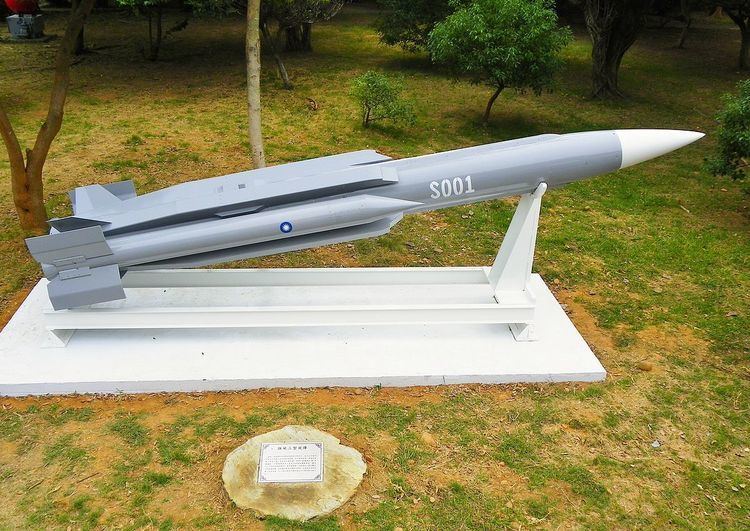 | ||
The Hsiung Feng III (HF-3; Chinese: 雄風三型, "Brave Wind III") is a supersonic missile. It represents the third generation of Taiwanese technology in the Hsiung Feng series of anti-ship missiles which have been developed by the National Chung-Shan Institute of Science and Technology (CSIST) in Taiwan.
Contents
Development
CSIST started a ramjet test vehicle program in 1994, and this project was later merged with the Hsiung Feng program. Flight testing of a prototype started in 2001. Operational testing and evaluation was started in 2004 and was completed by 2005, on board the PFG-1101.
Design
The missile uses the design of an integrated rocket ramjet, which not only minimizes its size and weight but also increases its operational flexibility. It uses a solid fuel main booster with two side-by-side solid-propellant jettisonable strap-on rocket boosters for initial acceleration and a liquid-fueled ramjet for sustained cruise. It also employs electronic counter-countermeasures (ECCM) capabilities allowing it to penetrate an enemy ship's defenses.
The missile is cylindrical in shape and composed of three sections, namely guidance and control, warhead, and propulsion. The body has four inlet ducts and and four clipped delta control surfaces. It used the inertial navigation system (INS) during mid-course navigation phase and active radar seeker at terminal guidance phase. The air intake design arrangement was reported to have been optimized for evasive maneuvering at terminal sea-skimming altitudes. The missile is designed to be capable of way-pointing and can be programmed to fly offset attack axes to saturate defenses. It is also capable of high-G lateral terminal "random weaving" maneuvers to evade close-in defenses.
The missile travels at supersonic speeds (Mach 2.5-Mach 3.0) at sea-skimming altitude with a special trajectory at the terminal phase, reducing the reaction time of the target ship. It also features an armor-piercing warhead which generates tremendous destruction after hitting the target. The warhead is equipped with self-forging fragments and in the 225 kg (496 lb) weight class. The warhead triggered by a smart fuze that directs most of the energy downwards, inside the target ship's hull.
The missile is believed to have an operating range of 150–200 km (93–124 mi; 81–108 nmi) with a possible maximum range of 300 km and a minimum range of 30 km. It can be deployed on ships and mobile trailers. The instructions for missile launch can be issued by a command and control system for different platforms and different paths leading to saturation of a ship's defense system. In February 2017, Taiwan revealed that it had increased the HF-III's range to 400 km (250 mi; 220 nmi).
Deployment
The missile was officially revealed on Oct. 10, 2007 at a military parade in Taipei, Taiwan. It has now been deployed aboard the ROC Navy's Lafayette/Kang Ding class firgate, Cheng Kung class frigate and Jin Chiang class patrol gunboat.
Misfire accident
On July 1, 2016, The Republic of China (Taiwan) Navy announced that a Hsiung Feng III missile had been accidentally fired 50 nautical miles towards the direction of the People's Republic of China (PRC) from the Chinchiang (PGG-610), a 500-ton patrol corvette. The accidentally misfired missile penetrated a fishing boat 50 nautical miles away, without explosion. Due to the classified nature of this issue Taiwan's Ministry of National Defence has given minimal information to the public; only that no detonation or explosion occurred; that the missile was retrieved by a combined search team from the Taiwan Coast Guard and Taiwan Navy; and that the accident killed the civilian captain of a fishing boat and injured another 3 members of the crew.
The Taiwan Ministry of National Defense said the warship’s commander, senior arms officer and missile launch control sergeant had all failed to follow standard operating procedure before the sailor chose the wrong operation mode, committing a series of careless mistakes that resulted in the accident. The ministry also said the navy dispatched two corvettes, four speedboats and two helicopters to search for the missile and immediately contacted the coast guard for assistance in recovery efforts.
